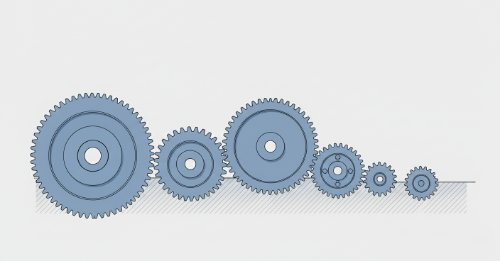Forces and reactions (1) - Introduction | 2D Kinetics of Rigid Bodies by Newton's Second Law - Engineering Mechanics (Undergraduate Advanced)
SPONSORED Get Personalized Tutoring NowStruggling with a tough concept or looking to advance your skills? Our expert tutors offer one-to-one guidance tailored to your unique needs.
Get instant support, clear explanations, and practical strategies to master even the most challenging subjects. With flexible scheduling and customized learning plans, success is just a session away.
Book your personalized tutoring today and start achieving your academic goals!
Get Personalized Tutoring NowStruggling with a tough concept or looking to advance your skills? Our expert tutors offer one-to-one guidance tailored to your unique needs.
Get instant support, clear explanations, and practical strategies to master even the most challenging subjects. With flexible scheduling and customized learning plans, success is just a session away.
Book your personalized tutoring today and start achieving your academic goals!
Struggling with a tough concept or looking to advance your skills? Our expert tutors offer one-to-one guidance tailored to your unique needs. Get instant support, clear explanations, and practical strategies to master even the most challenging subjects. With flexible scheduling and customized learning plans, success is just a session away. Book your personalized tutoring today and start achieving your academic goals!
 2D Kinetics of Rigid Bodies by Newton's Second Law - Engineering Mechanics (Undergraduate Advanced)Do you want to learn how to apply the laws of physics to analyze the motion of rigid bodies in two dimensions?
Do you want to understand the concepts and methods of mass moment of inertia, general equations of motion, work, energy, impulse, and momentum?
Do you want to design and optimize mechanical systems and devices that involve the rotation and translation of rigid bodies?
If you answered yes to any of these questions, then this course is for you!
In this course, you will learn the fundamentals of two-dimensional kinetics of rigid bodies, which is the branch of mechanics that deals with the relation between the forces acting on a rigid body and its resulting motion. The course will equip you with the skills and knowledge to solve various engineering and scientific problems involving the motion of rigid bodies in two dimensions. You will be able to apply the concepts and methods of two-dimensional kinetics of rigid bodies to fields such as mechanical engineering, aerospace engineering, civil engineering, robotics, biomechanics, and more. You will also be able to appreciate the power and elegance of the physical laws that govern the motion of rigid bodies.
By the end of this course, you will be able to:
- Define and explain the meaning of kinetics, rigid body, and plane motion
- Calculate the mass moment of inertia of a rigid body using integration or parallel axis theorem
- Derive and use the general equations of motion for a rigid body in plane motion
- Analyze the motion of a rigid body undergoing translation, rotation about a fixed axis, or general plane motion
- Apply the principle of work and energy to determine the motion of a rigid body or a system of rigid bodies
- Apply the principle of conservation of energy to determine the motion of a rigid body or a system of rigid bodies under conservative forces
- Apply the principle of impulse and momentum to determine the motion of a rigid body or a system of rigid bodies
- Apply the principle of conservation of momentum to determine the motion of a rigid body or a system of rigid bodies
Tailored for students, engineers, scientists, and anyone passionate about learning the basics of 2D kinetics of rigid bodies, this course assumes a basic background in calculus, physics, vector algebra, and statics.
Once enrolled, you have access to dynamic video lessons, interactive quizzes, and live chat support for an immersive learning experience. You engage with clear video explanations, test your understanding with instant-feedback quizzes and interact with our expert instructor and peers in the chat room. Join a supportive learning community to exchange ideas, ask questions, and collaborate with peers as you master the material, by enrolling right away.
2D Kinetics of Rigid Bodies by Newton's Second Law - Engineering Mechanics (Undergraduate Advanced)Do you want to learn how to apply the laws of physics to analyze the motion of rigid bodies in two dimensions?
Do you want to understand the concepts and methods of mass moment of inertia, general equations of motion, work, energy, impulse, and momentum?
Do you want to design and optimize mechanical systems and devices that involve the rotation and translation of rigid bodies?
If you answered yes to any of these questions, then this course is for you!
In this course, you will learn the fundamentals of two-dimensional kinetics of rigid bodies, which is the branch of mechanics that deals with the relation between the forces acting on a rigid body and its resulting motion. The course will equip you with the skills and knowledge to solve various engineering and scientific problems involving the motion of rigid bodies in two dimensions. You will be able to apply the concepts and methods of two-dimensional kinetics of rigid bodies to fields such as mechanical engineering, aerospace engineering, civil engineering, robotics, biomechanics, and more. You will also be able to appreciate the power and elegance of the physical laws that govern the motion of rigid bodies.
By the end of this course, you will be able to:
- Define and explain the meaning of kinetics, rigid body, and plane motion
- Calculate the mass moment of inertia of a rigid body using integration or parallel axis theorem
- Derive and use the general equations of motion for a rigid body in plane motion
- Analyze the motion of a rigid body undergoing translation, rotation about a fixed axis, or general plane motion
- Apply the principle of work and energy to determine the motion of a rigid body or a system of rigid bodies
- Apply the principle of conservation of energy to determine the motion of a rigid body or a system of rigid bodies under conservative forces
- Apply the principle of impulse and momentum to determine the motion of a rigid body or a system of rigid bodies
- Apply the principle of conservation of momentum to determine the motion of a rigid body or a system of rigid bodies
Tailored for students, engineers, scientists, and anyone passionate about learning the basics of 2D kinetics of rigid bodies, this course assumes a basic background in calculus, physics, vector algebra, and statics.
Once enrolled, you have access to dynamic video lessons, interactive quizzes, and live chat support for an immersive learning experience. You engage with clear video explanations, test your understanding with instant-feedback quizzes and interact with our expert instructor and peers in the chat room. Join a supportive learning community to exchange ideas, ask questions, and collaborate with peers as you master the material, by enrolling right away.
Do you want to learn how to apply the laws of physics to analyze the motion of rigid bodies in two dimensions? Do you want to understand the concepts and methods of mass moment of inertia, general equations of motion, work, energy, impulse, and momentum? Do you want to design and optimize mechanical systems and devices that involve the rotation and translation of rigid bodies? If you answered yes to any of these questions, then this course is for you! In this course, you will learn the fundamentals of two-dimensional kinetics of rigid bodies, which is the branch of mechanics that deals with the relation between the forces acting on a rigid body and its resulting motion. The course will equip you with the skills and knowledge to solve various engineering and scientific problems involving the motion of rigid bodies in two dimensions. You will be able to apply the concepts and methods of two-dimensional kinetics of rigid bodies to fields such as mechanical engineering, aerospace engineering, civil engineering, robotics, biomechanics, and more. You will also be able to appreciate the power and elegance of the physical laws that govern the motion of rigid bodies. By the end of this course, you will be able to: - Define and explain the meaning of kinetics, rigid body, and plane motion - Calculate the mass moment of inertia of a rigid body using integration or parallel axis theorem - Derive and use the general equations of motion for a rigid body in plane motion - Analyze the motion of a rigid body undergoing translation, rotation about a fixed axis, or general plane motion - Apply the principle of work and energy to determine the motion of a rigid body or a system of rigid bodies - Apply the principle of conservation of energy to determine the motion of a rigid body or a system of rigid bodies under conservative forces - Apply the principle of impulse and momentum to determine the motion of a rigid body or a system of rigid bodies - Apply the principle of conservation of momentum to determine the motion of a rigid body or a system of rigid bodies Tailored for students, engineers, scientists, and anyone passionate about learning the basics of 2D kinetics of rigid bodies, this course assumes a basic background in calculus, physics, vector algebra, and statics. Once enrolled, you have access to dynamic video lessons, interactive quizzes, and live chat support for an immersive learning experience. You engage with clear video explanations, test your understanding with instant-feedback quizzes and interact with our expert instructor and peers in the chat room. Join a supportive learning community to exchange ideas, ask questions, and collaborate with peers as you master the material, by enrolling right away.
 MEE 206: Engineering Mechanics - DynamicsMaster the principles governing the motion of engineering systems. This learning track provides a complete education in dynamics, systematically building from the kinematics of particles to the kinetics of rigid bodies and culminating in an introduction to dynamic systems and vibration. You will learn to analyse and predict how mechanical systems behave under the influence of forces.
This programme is for undergraduate students in mechanical, aerospace, civil, or related engineering disciplines. It is also essential for practising engineers and applied scientists who require a rigorous, first-principles command of dynamic analysis for their professional work. A prerequisite knowledge of statics, calculus, and vector algebra is assumed.
Upon completion, you will possess the analytical tools to solve complex dynamics problems for particles and rigid bodies using force, energy, and momentum methods. This provides the essential foundation for advanced study in mechanical design, control systems, and structural analysis, and prepares you for demanding technical roles in the engineering sector.
MEE 206: Engineering Mechanics - DynamicsMaster the principles governing the motion of engineering systems. This learning track provides a complete education in dynamics, systematically building from the kinematics of particles to the kinetics of rigid bodies and culminating in an introduction to dynamic systems and vibration. You will learn to analyse and predict how mechanical systems behave under the influence of forces.
This programme is for undergraduate students in mechanical, aerospace, civil, or related engineering disciplines. It is also essential for practising engineers and applied scientists who require a rigorous, first-principles command of dynamic analysis for their professional work. A prerequisite knowledge of statics, calculus, and vector algebra is assumed.
Upon completion, you will possess the analytical tools to solve complex dynamics problems for particles and rigid bodies using force, energy, and momentum methods. This provides the essential foundation for advanced study in mechanical design, control systems, and structural analysis, and prepares you for demanding technical roles in the engineering sector.
Master the principles governing the motion of engineering systems. This learning track provides a complete education in dynamics, systematically building from the kinematics of particles to the kinetics of rigid bodies and culminating in an introduction to dynamic systems and vibration. You will learn to analyse and predict how mechanical systems behave under the influence of forces. This programme is for undergraduate students in mechanical, aerospace, civil, or related engineering disciplines. It is also essential for practising engineers and applied scientists who require a rigorous, first-principles command of dynamic analysis for their professional work. A prerequisite knowledge of statics, calculus, and vector algebra is assumed. Upon completion, you will possess the analytical tools to solve complex dynamics problems for particles and rigid bodies using force, energy, and momentum methods. This provides the essential foundation for advanced study in mechanical design, control systems, and structural analysis, and prepares you for demanding technical roles in the engineering sector.